Khanna A.S. (Ed.) High-Performance Organic Coatings: Selection, application and evaluation
Подождите немного. Документ загружается.

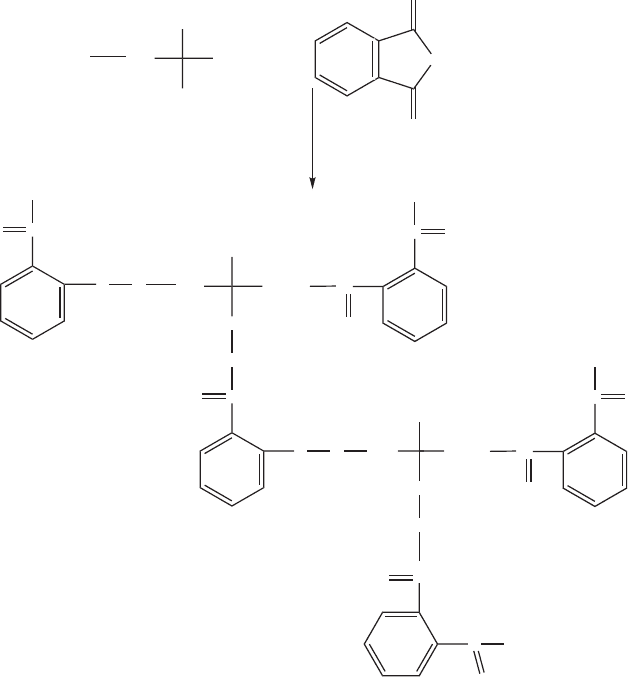
256 High-performance organic coatings
O
O
O
CH
2
OH
CH
2
OH
CH
2
OH
CH
3
CH
2
+
Anhydride
CH
2
CH
2
O
CH
2
CH
3
CH
2
OC
C
OH
O
O
CO
C O CH
2
CH
2
O
CH
2
CH
3
CH
3
C
O
C
OH
O
C
O
C
OH
O
O
C
O
C OH
O
Polyol
13.4 Synthesis of a conventional solventborne hydroxy functional
polyester resin.
case of dimethylolpropionic acid, the hydroxy acid is condensed through
the OH group, leaving the carboxyl group for neutralization.
13.7.3 Alkyd
Alkyds [6] are reaction products of polyhydric alcohol, polybasic acid and
fatty acid (Fig. 13.7). Some techniques to incorporate the water solubility
in alkyds are as follows:
• The oldest method of making waterborne alkyd involves an interrupt
reaction technique in which conventional polymerization is halted at a
© 2008, Woodhead Publishing Limited
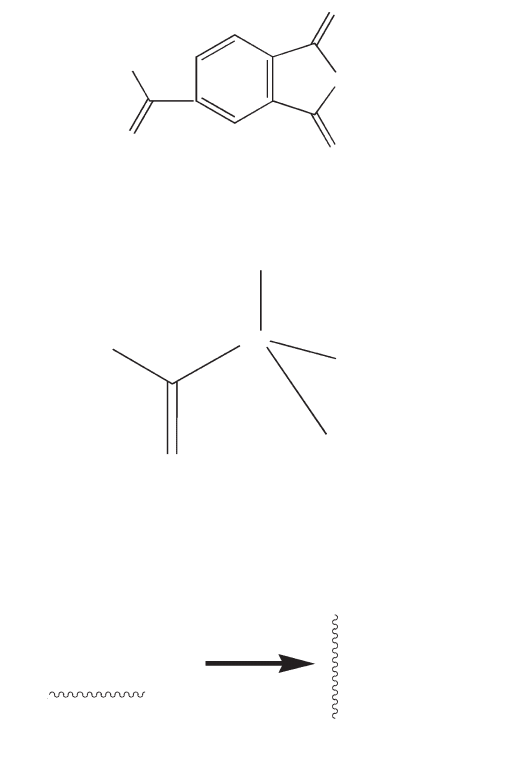
Waterborne coatings for corrosion protection 257
HO
HO
O
O
C
2
H
5
CH
2
OH
CH
2
OH
Hydroxy1 group
Acidic group
Acidic group
Acid anhydride moiety
Dimethylpropionic acid acts as a polyol
Trimetallic anhydride acts as an acid
C
O
O
O
13.5 Precursor for waterborne polyester: hydroxy acid as polyol and
trimetallic acid as acid.
R
3
N
Amine
+
HOOC COOH
COO
–
Soluble in water
COO
–
HNR
3
+
HNR
3
+
Quaternary ammonium salt
of polyester
Carboxylated polyester
Insoluble in water
13.6 Solubilization of carboxylic group-terminated polyester.
high acid value, allowing the resultant polymer to be neutralized and
water solubilized.
triethylene glycol also makes them water soluble. However, these water-
sensitive to water.
• In this technique, alkyds are produced with residual acidity (pendent
carboxylic acid groups) and further neutralized with volatile amines to
get a temporary water-soluble amine salt. When used in coatings during
curing, the amine salt dissociates as the amine evaporates.
• Modification of alkyds with water-loving polyether polyols such as di- or
loving groups remain in the film after drying and make the coating more
© 2008, Woodhead Publishing Limited
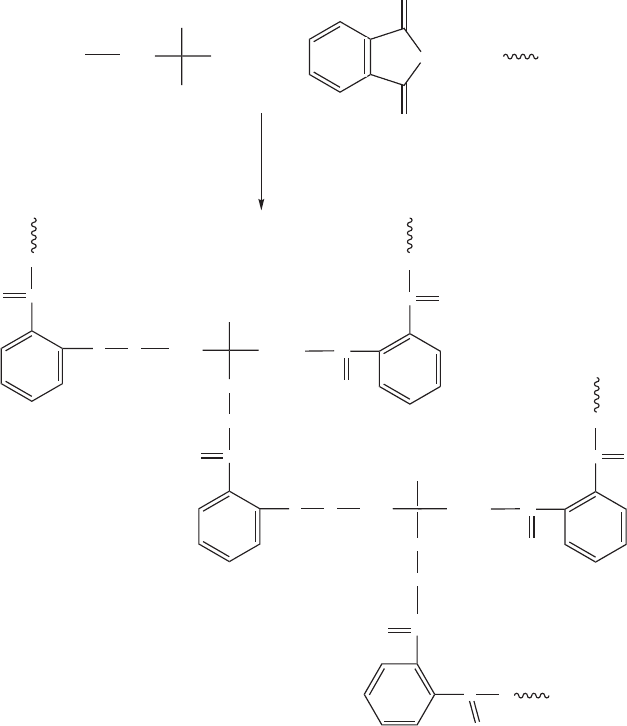
258 High-performance organic coatings
O
O
O
CH
2
CH
2
OH
CH
2
OH
CH
2
OH
2CH
3
+ 2 + 2 COOH
Anhydride Fatty acid
+ 7 water
Alkyd resin
CH
2
CH
2
O
CH
2
CH
3
CH
2
OC
C
O
O
O
CO
C O CH
2
CH
2
O
CH
2
CH
3
CH
3
C
O
C
O
O
C
O
C
O
O
O
C
O
C O
O
Polyol
13.7 Synthesis of an alkyd.
• Higher molecular weight polymers can be produced by a two-step reac-
tion which involves the initial polymerization of an alkyd with a hydroxyl
value higher than normal hydroxyl value, and then reaction of the pro-
duced material with additional anhydride to give the carboxylated
polymer.
13.7.4 Epoxy
Epoxies [2] are hydrophobic in nature and can be made water soluble by
reaction with a suitable amine or an acid. The final product between epoxy
© 2008, Woodhead Publishing Limited
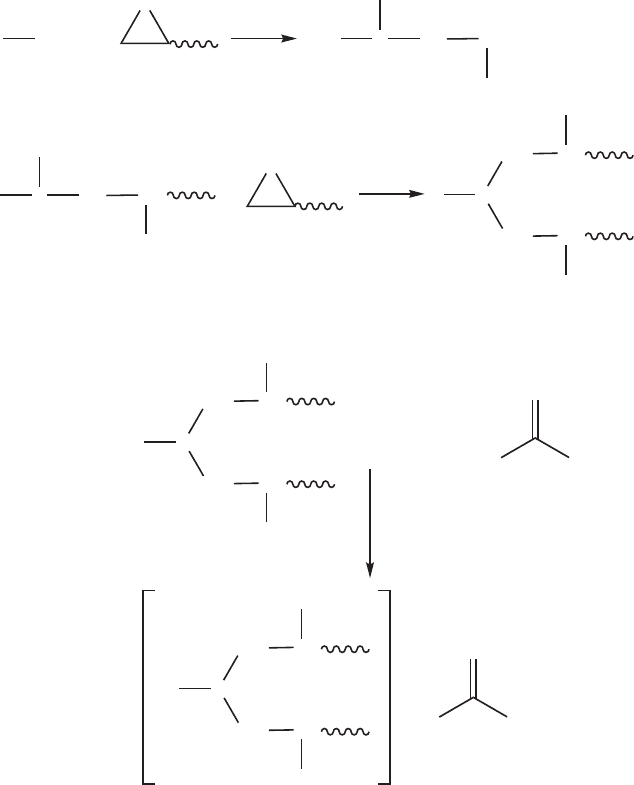
Waterborne coatings for corrosion protection 259
resins and primary or secondary amines is a tertiary amine which can be
neutralized with an acid to form a water-reducible quaternary ammonium
salt. Whereas acids on reaction with epoxy resin give acid-functional epoxy
ester which can then be neutralized with organic amine (Figs 13.8 and 13.9),
the tertiary nitrogen atoms on the epoxy molecule react with an acid to
generate a water-soluble ammonium salt. Figure 13.10 shows commercially
RNH
2
+
O
RNCH CH
OH
H
Reaction with another epoxy group to form tertiary amine
Reaction with an epoxy group to form secondary amine
RN
CH CH
OH
H
O
+
RN
CH
2
CH
2
CH
CH
OH
OH
Neutralization of tertiary amine with an acid
RN
CH
2
CH
2
CH
CH
OH
OH
+
R OH
O
RN
CH
2
CH
2
CH
CH
OH
OH
R O
–
O
+
Water-soluble epoxy
13.8 Solubilization of epoxy resin by reaction with amine and neutral-
ization by acid.
© 2008, Woodhead Publishing Limited
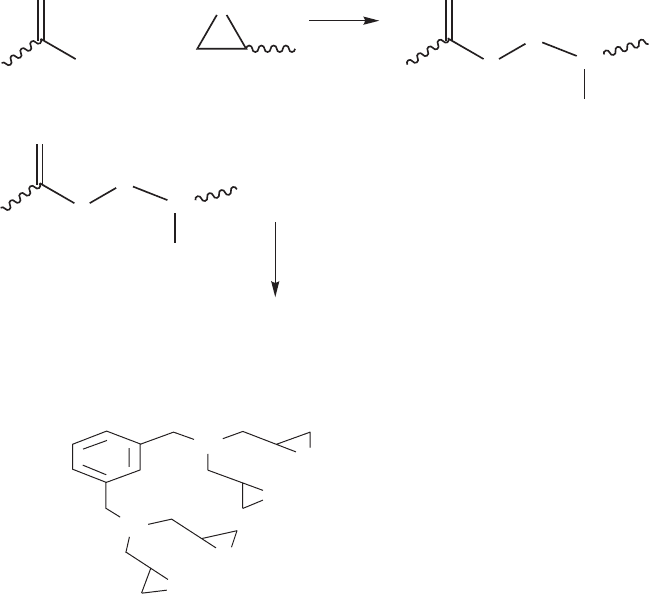
260 High-performance organic coatings
O
OH
+
O
O
O
H
C
CH
OH
Neutralization of epoxy ester
O
O
H
C
CH
OH
+R
3
N
neutralization
Water-soluble epoxy resin
13.9 Solubilization of epoxy resin by reaction with organic acid
followed by amine neutralization.
N
N
O
O
O
O
13.10 Chemical structure of
N,N,N′,N′-tetraglycidyl-meta-xylylenediamine.
available liquid N,N,N′,N′-tetraglycidyl-meta-xylylenediamine which can
be made water soluble by reaction with acetic acid.
In the liquid epoxy resin system, the curing agent component is a water-
polyamides or polyamine-epoxy adducts which are rendered water soluble
by salting with a volatile organic acid such as acetic acid.
There are two fundamentally different methods to solubilize epoxy resin.
when the liquid epoxy and the aqueous solution of the amine components
are mixed together. The dispersed resin particles contain both epoxy and
curing agent (Fig. 13.11). In the second method, solid epoxy resin pre-
Esterification of epoxy resin by organic acid
borne/water-reducible modified amine which serves the dual function of
curative and emulsifying agent for the resin. The curing agents are modified
The first method utilizes liquid epoxy resin. Typically, the amine curing
agent serves as an emulsifier for the epoxy, and the emulsion is formed
© 2008, Woodhead Publishing Limited
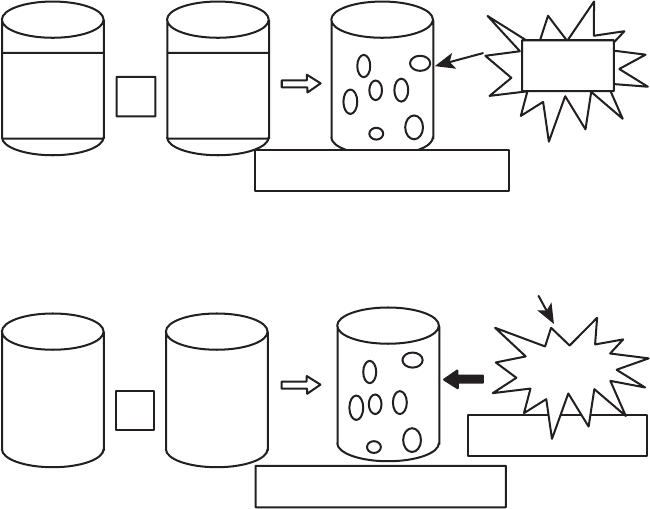
Waterborne coatings for corrosion protection 261
dispersed in water and co-solvent was used (Fig. 13.12). The dispersed resin
particles contain only solid epoxy resin, so that the curing agent must
migrate from the aqueous phase into the dispersed epoxy particles for reac-
tion to occur.
13.7.5 Polyurethane
Polyurethane [7, 8], an ester of carbamic acid, is the reaction product of an
isocyanate (—NCO) and an alcohol (—OH). Polyurethane can be made
water soluble using either dispersing agents or by ionic stabilization (Fig.
13.13). Ionically stabilized polyurethane is a one-component, linear struc-
tured polymer that does not contain any free isocyanate group.
Cationic polyurethane dispersion
These polymers are prepared by incorporating tertiary amine functionality
into the backbone followed by quaternization with an alkylating agent or
protonation with a suitable acid. The degree of solubility of these polymers
in water depends on the degree of quaternary ammonium group concentra-
Liquid
epoxy
Curing agent–epoxy emulsion
Emulsion particle
Curing
agent
+
+
Aqueous
solution of
curing
agent
13.11 Solubilization of epoxy resin: method 1.
Solid
epoxy
dispersion
Curing
agent
Dispersed epoxy phase
Emulsion particle
Solid
epoxy
+
Curing agent
13.12 Solubilization of epoxy resin: method 2.
© 2008, Woodhead Publishing Limited

262 High-performance organic coatings
tion. However, the compatibility of these polymers with pigments, additives
and other dispersions is inadequate.
Anionic polyurethane dispersion
Anionic polyurethane dispersions are generally prepared from diols and
bifunctional isocyanates, with dispersible functional groups such as carbox-
using small amounts of an auxiliary diol such as dimethylpropionic acid. A
tertiary amine such as trimethylamine can also be used to produce a stable
dispersion of the product in water. Here again, the general method of
obtaining a polyurethane dispersion involves incorporating hydrophilic
NH C OH
O
C
O
O
NHO
O
– +
NH
3
R
C
Cationic polyurethane dispersion
Anionic polyurethane dispersion
NH C O
O
CH
2
CH
2
N
+
CH
2
CH
2
C O NH
O
Non-ionic polyurethane dispersion
NH C O
O
CH
2
CH
2
N
+
CH
2
CH
3
NH
2
O CH
2
CH
2
O CH
2
CH
2
CH
3
13.13 Polyurethane dispersions.
ylic acids built into the backbone. Acidification is generally achieved by
centres as internal emulsifiers into the chain of the polyurethane.
© 2008, Woodhead Publishing Limited
Waterborne coatings for corrosion protection 263
Non-ionic polyurethane dispersion
In non-ionically stabilized polyurethane dispersion, the hydrophilic centres
consist of polyether chain segments that are attached to or incorporated in
polymer.
occurs a certain physical crosslinking caused by:
• Electrostatic forces between hydrophilic groups (coulomb force)
• Hydrogen bonding between urethane groups
• Interaction between hydrophobic segments of the chain.
13.7.6 Acrylics
Carboxylic acid-functional acrylic polymer of molecular weight between
20 000 and 50 000 with a minimum acid value of 50 mg KOH/g can be made
water soluble by neutralizing pendent carboxylic acid using amines. Acrylic
monomers have been copolymerized into the polyurethane and dispersions
of this true copolymer are widely available on the market. Typical systems
are prepared from IPDI and polypropylene glycol copolymerized with
methyl methacrylate and butyl acrylate.
13.7.7 Silicone
Silicone polymers [9] are a class of hybrid organic/inorganic polymers that
have been used in aqueous as well as non-aqueous systems. Silicones show
excellent performance as surface active agents in both aqueous and non-
aqueous systems in reducing the surface tension to as low as 21 mN/m.
However, on a nanometre scale silicone often forms a third phase instead
of solubilizing in hydrophilic and a variety of hydrophobic solvents. It can
the emulsion. Silicone emulsions typically consist of water, silicone oil and
a surfactant.
Silicon readily expands its valence shell under nucleophilic substitution
more easily than its carbon analogues. Chlorosilanes are the most common
substrate for displacement reactions, producing a number of organosilanes
on substitution of chloride by varieties of organic moieties (Fig. 13.14).
Chlorosilanes, which undergo nucleophilic substitution, are the most
common substance for the preparation of precursors for sol-gel coating
under mild conditions. They can be prepared by the Rochow process (syn-
thesis of organosilicon halides) and organometallic coupling reactions
(Grignard reagent). Silicon alkoxide can also be incorporated into the
polymer backbone via free-radical polymerization through a vinyl moiety,
During drying or film formation of urethane dispersions, there probably
either be used as an emulsifier or acts as the continuous/disperse phase of
© 2008, Woodhead Publishing Limited
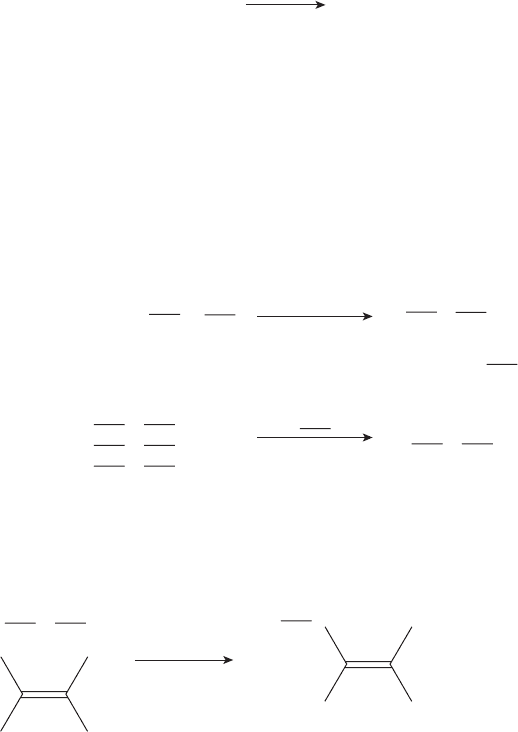
264 High-performance organic coatings
via a condensation reaction with an organic moiety on the silicon alkoxide
monomer, or via a post-reaction (such as a hydrosilylation reaction).
Silicones are water repellent, heat stable, and highly resistant to chemical
attack as compared to their organic counterparts. Owing to these special
cone polymers as shown in Table 13.5 are polydimethylsiloxane, epoxy
silane and amino silane and their derivative polymers that have been com-
M
Hydroxylation reaction
This is the most important method to prepare organo silane by addition of hydrosilane
across a carbon–carbon double bond.
Synthesis of organosilanes
Synthesis of organosilane halides
RCl
+
Si
Cu
>300°C
R
x
SiCl
4–x
[Rochow process]
Vapour of alkyl
or aryl halide
Silicon
Organosilicon
halide
Generation of silicon–carbon bond by organometallic compound
The reaction of organometallic reagent with functionalized silane in a polar solvent
generates a silicon–carbon bond. Other reagents are organolithium, organozinc,
organosodium.
The inherent reactivity of silicon also provides an opportunity to displace easily accessible
leaving groups like OR, OC(O)R and SR, in which R is an alkyl or aryl group, in the
presence of organometallic reagent.
SiCl
4
+
RMgX
R
Si Cl
3
R
3
Si SR
R
3
Si H
R
3
Si
R
3
Si
R′′
R
3
Si
OC(O)R′
R
3
Si
OR′
Silicon
tetrachloride
Grignard reagent
Addition of organic moiety
C bond
R′′
Pd(PPh
3
)4
H
+
′R′ to Si by Si
13.14 Synthesis of precursors for sol-gel coating.
properties, silicones are finding applications in paints. Commonly used sili-
© 2008, Woodhead Publishing Limited

Waterborne coatings for corrosion protection 265
mercialized extensively. These organic moieties should have a hydrophilic
nature or can be made hydrophilic before utilizing them in waterborne
coating formulations.
13.8 Additives in waterborne coatings
Additives in waterborne coatings are used to improve the rheology, wetting,
thaw stabilization, corrosion resistance and stability in UV. Additives may
be in the form of surfactants, thaw stabilizers, dispersants, corrosion inhibi-
tors, light and heat stabilizers, or coalescing agents [2, 10].
Epoxy silane
2-(3,4-epoxycyclohexyl) ethyltriethoxysilane
O
O
Si
OCH
3
OCH
3
OCH
3
2-(3,4-epoxycyclohexyl) ethyltrimethoxysilane
5,6-epoxycyclohexyltrimethoxysilane
(3-glycidoxypropyl) dimethylethoxysilane
(3-glycidoxypropyl) trimethoxysilane
Acrylic silane
(methacryloxymethyl)triethoxysilane
Si
OCH
3
OCH
3
OCH
3
H
2
C
C
CH
3
C
O
OCH
2
o-(methacryloethyl)-N-(triethoxysilipropyl)
urethane
Vinyl-derived silane
vinyltrimethoxysilane
Si
OCH
3
OCH
3
OCH
3
vinyltriacetoxysilane
vinyltris(methylethylketoximino)-silane
Amine silane
N-(2-aminoethyl)-3-aminoisobutyltrimethoxysilane
H
2
N
Si
OCH
3
OCH
3
OCH
3
N-(6-aminohexyl)aminopropyltrimethoxysilane
4-aminobutyltriethoxysilane
p-aminophenyltrimethoxysilane
3-aminopropyltris(methoxyethoxyethoxy)silane
Thiol-based silane
3-mercaptopropyltriethoxy
Si
OCH
3
OCH
3
OCH
3
HS
3-mercaptopropyltrimethoxy
Isocyanate-based silane
3-isocynatopropyltrimethoxysilane
Si
OCH
3
OCH
3
OCH
3
OCN
3-isocyanatopropyltrimethoxysilane
Others
Table 13.5 Organically modified silane
ureidopropyltriethoxy, fluorotrimethoxysilane
© 2008, Woodhead Publishing Limited
